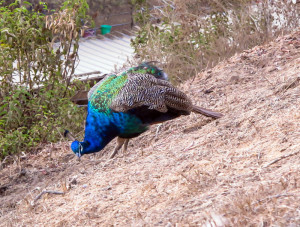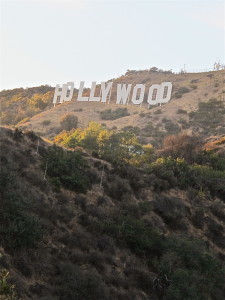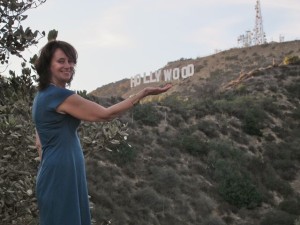 “Peacocks in Hollywood?” You might ask. “What’s so strange about that? Isn’t everyone strutting their stuff there?” Well, maybe. However, the type of peacock I’m referring to is the original feathered peafowl variety, and that wasn’t exactly what I was expecting to run into in the Hollywood Hills.
“Peacocks in Hollywood?” You might ask. “What’s so strange about that? Isn’t everyone strutting their stuff there?” Well, maybe. However, the type of peacock I’m referring to is the original feathered peafowl variety, and that wasn’t exactly what I was expecting to run into in the Hollywood Hills.
I’d taken a trip to get as close as I could to the famous Hollywood sign located above the city in the Hollywood Hills. After many false turns, (directions will follow atthe end of this post) I found myself on a promising residential road heading directly toward the sign. Initially straight, the road narrows, then twists and turns through an exquisite neighborhood of houses built in the early days of Hollywood movies; all architecturally fanciful and individual in nature. Then the road turns to dirt and ends abruptly in a rough parking lot. This is the beginning of theHollyridge Trail that will take you very close to the Hollywood sign.
Hollywood Peacocks
 It is a steep, dusty, and hot hike uphill, but definitely rewarding because very quickly the Hollywood sign appears close enough for some great sunset shots and views out over Griffith Park and the city. I stopped hiking where the trail widens into an overlook, but you can continue to hike up to a point right above the sign and actually look down on the letters.
It is a steep, dusty, and hot hike uphill, but definitely rewarding because very quickly the Hollywood sign appears close enough for some great sunset shots and views out over Griffith Park and the city. I stopped hiking where the trail widens into an overlook, but you can continue to hike up to a point right above the sign and actually look down on the letters.
Standing there admiring the sign, I heard the shrieks, (you can’t mistake a peacock or peahen’s call as it’s pretty unnerving) and saw a group of them, a muster, strutting and foraging around on the dry hillside just above me.I was more captivated by that sight than I was by the sign. I thought, “What on earth are they doing here?”
A Long History
It turns out that these particular peafowl have taken up residence (but not as pets) with the hens, roosters and horses at the Sunset Ranch Stables near the trailhead below. But it also turns out these aren’t the only feral peafowl in the Los Angeles area. Although originally imported to be captive and ornamental, at least one other muster has broken free from captivity, struck out on its own, and formed a thriving colony. Hundreds of peafowl, possibly more, can be found living wild in an upscale suburb southwest of Los Angeles on the Palos Verdes Peninsula. They are the descendents of the original peahen and peacock imported to grace the grounds of the first grand estate built there in the 1920s.
Most residents of Palos Verdes welcome the peafowl, who bring an unexpected and exotic look to the estate. However, several birds have been killed recently. Why anyone should commit this fowl crime is unclear, but some residents think that the perpetrator is angered by peacocks behaving like peacocks. They like to strut their stuff (and leave their droppings) on expensive cars and peck admiringly at their reflections in the glossy paintwork and chrome. Not exactly endearing qualities. And there are those blood–curdling calls. But as members of an avian colony that’s almost 100 years old, the peafowl of Palos Verdes were there long before the houses were built, and their longevity has earned them wildlife status and protection. An investigation by police into the killings is underway.
Considering the sheer size of peafowl (as opposed to a sparrow for example), living free in a city such as Los Angeles is an amazing accomplishment. It appears that Hollywood in particular likes peahens and peacocks of all varieties – both the avian and (as a walk down Hollywood Boulevard will attest) the human varieties as well!
Directions to the Hollyridge Trail:
 At the time of publishing this Blog the City of Los Angeles is installing gates at the end of Beachwood drive where the road ends and becomes a dirt track leading up to Hollyridge trail. No parking space will be provided but access to Hollyridge Trail is expected to remain. The following link provides excellent directions to access the trail and sign.
At the time of publishing this Blog the City of Los Angeles is installing gates at the end of Beachwood drive where the road ends and becomes a dirt track leading up to Hollyridge trail. No parking space will be provided but access to Hollyridge Trail is expected to remain. The following link provides excellent directions to access the trail and sign.

Leave a Reply